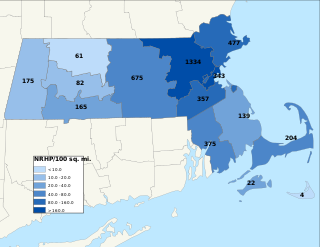
The National Register of Historic Places is a United States federal official list of places and sites considered worthy of preservation. In the state of Massachusetts, there are over 4,300 listings, representing about 5% of all NRHP listings nationwide and the second-most of any U.S. state, behind only New York. Listings appear in all 14 Massachusetts counties.
These are the National Registered Historic Places listings in Lowell, Massachusetts.
This National Park Service list is complete through NPS recent listings posted December 20, 2024.

The Newtonville Historic District is a historic district in the village of Newtonville, in Newton, Massachusetts. The district encompasses the southern portion of the village's business district, as well as surrounding residential areas. It was listed on the National Register of Historic Places in 1986, and enlarged in 1990.

The West Parish Center District encompasses the social and religious center of the part of Andover, Massachusetts, that is located west of the Shawsheen River. It is mostly spread along Lowell Street on either side of a major intersection with four other roads: Shawsheen Road, Reservation Road, Beacon Street, and High Plain Road. The centerpiece of the district is the 1826 West Parish Church, which is the oldest church standing in Andover. It is an elegant Federal style granite structure topped with a wooden steeple, added in 1863. The roof is made of Spanish tile, which was probably part of changes made around 1908. Opposite the church on the south side of the common is the West Parish Cemetery, which began as a small burying ground in the 1790s, and was substantially enlarged and restyled in the early 1900s.

The Spring Hill Historic District is a historic district roughly bounded by Summer, Central, Atherton, and Spring Streets in the Spring Hill area of Somerville, Massachusetts. The district encompasses the city's best-preserved residential subdivision from the mid-19th century, with later infill construction in the late 19th and early 20th centuries. The district was listed on the National Register of Historic Places in 1989.

The Joseph Bancroft House is a historic house in Reading, Massachusetts. Built in the early 1830s, it is a prominent local example of Federal period architecture. It was built for a member of the locally prominent Bancroft family, who inherited a large tract of land in the area. The house was listed on the National Register of Historic Places in 1984.
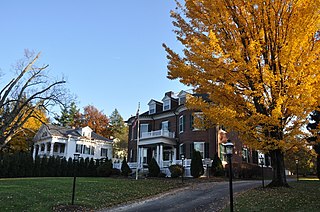
The Andover Street Historic District is a linear residential historic district in the Belvidere neighborhood of eastern Lowell, Massachusetts. The district encompasses large, fashionable houses and estates that were built between the 1860s and the 1930s. It includes properties at 245—834 Andover Street, and at 569 and 579 East Merrimack Street. The district was listed on the National Register of Historic Places in 2000.
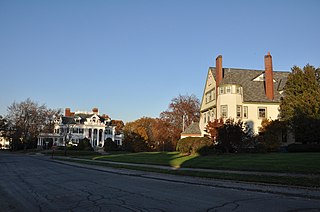
The Belvidere Hill Historic District encompasses a residential area on the east side of Lowell, Massachusetts known for its fine 19th-century houses. The area, roughly bounded by Wyman, Belmont, Fairview, and Nesmith Streets, was developed beginning in the 1850s, and was one of the finest neighborhoods in the city, home to many of its business and civic leaders. It was listed on the National Register of Historic Places in 1995.

The 1895 Lowell Post Office is an historic post office building at 89 Appleton Street in Lowell, Massachusetts. The imposing two-story granite building was completed in 1895 to a design by W. J. Edbrooke. The building has an H shape, and has a profusion of typical Richardsonian Romanesque features, included rounded arches over windows and a recessed entry. The focal point of the building is its five-story square clock tower, which is topped by a pyramidal roof supported by tripled round arches on each face.

The Jonathan Bowers House is an historic house in Lowell, Massachusetts. Built in 1872 for a local businessman, it is one of the most unusual houses in Massachusetts, being a circular masonry building with Second Empire styling. It was listed on the National Register of Historic Places in 1976.

The Hoyt-Shedd Estate is a historic residential estate at 386-396 Andover Street and 569-579 East Merrimack Street in Lowell, Massachusetts. The houses at 386 and 396 Andover Street are large Stick style mansions, built about the same time and designed by the same architect. They were built for the friends and business partners E. W. Hoyt and F. B. Shedd. Together they made a fortune selling perfume and related products.
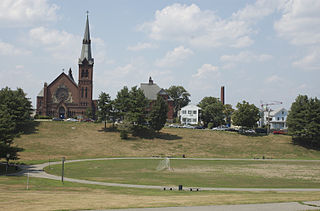
The South Common Historic District of Lowell, Massachusetts, encompasses the city's South Common and the various public, religious, and private residential buildings that flank its borders. The South Common, about 22.5 acres (9.1 ha) in size, was purchased by the city in 1845 in an auction by the Proprietors of Locks and Canals, who owned much of the city's industrial area. Although the common was landscaped, it was not apparently done so to a plan. It quickly became lined with fashionable residences, and several iconic public buildings, including the 1850 courthouse, a Romantic Revival structure designed by Ammi Young, and a series of Gothic Revival churches. Highland Avenue was built out with a series of fine Italianate houses.
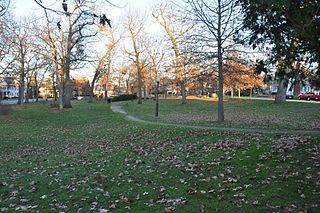
The Tyler Park Historic District encompasses a planned residential development in western Lowell, Massachusetts. The development was designed by Olmsted, Olmsted and Eliot, and is centered on Tyler Park; this area is the only Olmsted design in the city. It is roughly bounded by Princeton, Foster, and Pine Streets. Except for a few early houses that predate the subdivision, the area was built out between 1888 and 1936, and reflect the architectural styles popular in the period.

The Worcester House is a historic house at 658 Andover Street in Lowell, Massachusetts. This vernacular Federal style farmhouse was built c. 1802 by Eldad Worcester, on land originally purchased by his grandfather, and is the oldest house on Andover Street. The area remained farmland through most of the 19th century. The house is architecturally unusual for the period, with a four-bay facade and its main entrance located on one of the sides.

The Wannalancit Street Historic District is a historic district at 14-71 Wannalancit St., and 390, 406 Pawtucket Street in Lowell, Massachusetts. This section of Wannalancit Street includes a remarkably well preserved and distinctive 19th century houses, representing a cross section of popular architectural styles of the period. The most unusual house in the district is the round Jonathan Bowers House ; the oldest building is a c. 1853 vernacular Greek Revival cottage at 22 Wannalancit Street.
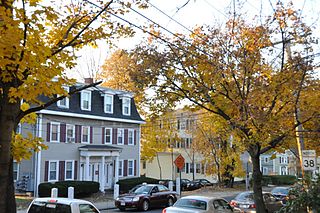
The Washington Square Historic District of Lowell, Massachusetts encompasses a historic subdivision laid out in 1832. The focal point of the subdivision is Kittridge Park, which lies on the eastern side of the district and was an original part of the subdivision plan developed by the Nesmith Brothers. It was the first significant residential subdivision in the city aimed at a wealthier clientele, and was designed by landscape architect Alexander Wadsworth. The district was added to the National Register of Historic Places in 1982, and expanded slightly in 1999.

The House at 556 Lowell Street in Wakefield, Massachusetts is a high style Queen Anne Victorian in the Montrose section of town. The 2+1⁄2-story wood-frame house was built in 1894, probably for Denis Lyons, a Boston wine merchant. The house is asymmetrically massed, with a three-story turret topped by an eight-sided dome roof on the left side, and a single-story porch that wraps partially onto the right side, with a small gable over the stairs to the front door. That porch and a small second-story porch above are both decorated with Stick style woodwork. There is additional decoration, more in a Colonial Revival style, in main front gable and on the turret.

The Daniel Sweetser House is a historic house at 458 Lowell Street in Wakefield, Massachusetts. The 2+1⁄2-story timber-frame house was built sometime before 1795, probably for Daniel Sweetser, who then occupied the property. It is a conservative Federal style house with two interior chimneys, and is one of the town's better preserved rural properties of the period. Its most notable resident was James Mansfield, the town's first postal letter carrier.
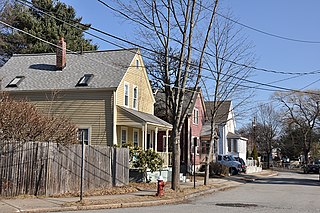
The Saco–Lowell Shops Housing Historic District encompasses the only 20th-century factory working housing enclave in the city of Newton, Massachusetts. It is located in Newton Upper Falls, near the Saco–Pettee Machine Shops, and was developed to provide housing for employees of the machinery manufacturers located there. It is roughly bounded by Oak, Williams, Butts, and Saco Streets, and includes eight small-scale brick houses with vernacular Colonial Revival styling. These houses were built in 1919 and 1920, adjoining a small number of worker houses built in the early 1890s. The district was listed on the National Register of Historic Places in 1990.

Otis A. Merrill was an American architect. In association with various partners he practiced architecture in Lowell, Massachusetts, from 1873 until 1900.






















